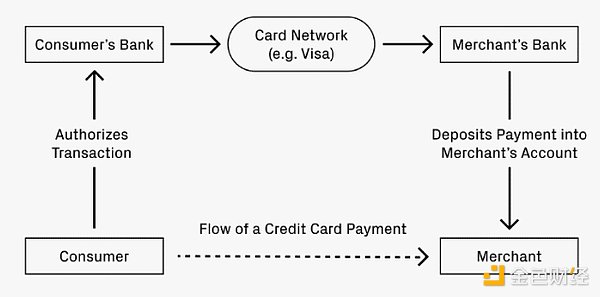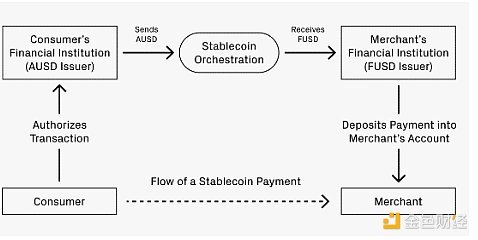Author: Alana, Variant Fund Investment Partner; Translation: Jinse Finance xiaozou
Stablecoins are the most transformative form of payment since the credit card, changing the way money moves. With low cross-border fees, near-instant settlement, and global accessibility, stablecoins have the power to revolutionize the financial system. For those who custody USD deposits backing digital assets, stablecoins could also be a very lucrative business.
Today, the global supply of stablecoins exceeds $150 billion. There are five stablecoins with at least $1 billion in circulation: USDT (Tether), USDC (Circle), DAI (Maker), First Digital USD (Binance), and PYUSD (PayPal). I believe that in our future world, all financial institutions will issue their own stablecoins.
I’ve been thinking about what opportunities the growth of stablecoins might bring, and I think looking at the maturation of other payment systems — especially credit card networks — might provide some answers.
1. How similar are credit card and stablecoin networks?
All stablecoins should feel like the U.S. dollar to consumers and merchants. But in reality, each stablecoin issuer treats the dollar differently—due to different issuance and redemption processes, reserve backing for each stablecoin supply, different regulatory regimes, frequency of financial audits, and more. Reconciling these complexities is undoubtedly a daunting task.
We’ve seen this before with the evolution of credit cards. Consumers spend using assets that are almost-but-not-quite-fungible, representing dollars (they’re loans in dollars, but those loans aren’t fungible because people have different credit scores). Some network (like Visa and Mastercard) handles the payment orchestration for the whole system. The stakeholders in both systems look (or eventually will) very similar: the consumer, the consumer’s bank, the merchant’s bank, and the merchant.
The following example may help to reveal the similarities in the network structure.
● Suppose you go out to eat and pay with a credit card. How does your payment get into the restaurant's account?
● Your bank (the credit card issuer) will authorize the transaction and send the funds to the restaurant’s bank (called the acquirer).
● An exchange network — like Visa or Mastercard — facilitates the exchange of funds and takes a small fee.
● The first order line then deposits the funds into the restaurant’s account (minus fees).

Now let's say you want to pay using a stablecoin. Your bank (Bank A) issues the AUSD stablecoin. The restaurant's bank (Bank F) uses FUSD. These are two different stablecoins, although they both represent USD. The restaurant's bank only accepts FUSD. How are AUSD payments converted to FUSD?
This process should end up looking very similar to what the credit card networks do:
● The consumer’s bank (which issues AUSD) authorizes the transaction.
● The orchestration service supports the exchange of AUSD to FUSD and may charge a small fee. This exchange can occur in at least the following ways:
Method 1: Exchange stablecoins for stablecoins on a decentralized exchange. For example, Uniswap offers many such pools with fees as low as 0.01%.
Method 2: Use AUSD to exchange for USD deposits, and then deposit these USD into the first order line to obtain FUSD.
Approach 3: Orchestration services can net traffic to each other over the network, but this will likely only happen with scale.
● FUSD is deposited into the merchant account (minus a fee of course).

2. Where to upgrade and surpass?
The above is what I see as clear parallels between credit card and stablecoin networks. It also provides a useful framework for thinking about where stablecoins start to meaningfully scale and surpass credit card networks.
The first is cross-border transactions. If the scenario above is an American consumer checking out at a restaurant in Italy - the consumer wants to pay in US dollars, and the merchant wants to accept euros - existing credit cards will charge more than 3%. Exchanges between such stablecoins on decentralized exchanges may only charge 0.05% (a 60-fold difference). If this magnitude of fee reduction is widely applied to cross-border payments, it goes without saying how much productivity stablecoins can contribute to global GDP.
The second is the flow of payments from businesses to individuals. The time between authorizing a payment and the funds actually leaving the payer's account is very fast: once authorized, the funds can leave the account. Instant settlement is valuable and everyone wants it. In addition, many businesses have employees spread across the globe. The frequency and size of cross-border payments can be much higher than for the average individual consumer. The continued globalization of the workforce should provide a strong impetus in this area.
3. Where might opportunities arise?
If the comparison between network structures is directionally correct, it can help reveal where entrepreneurial opportunities may exist. In the credit card ecosystem, the main businesses have spread across orchestration, issuance innovation, form support, etc. The same may be true for stablecoins.
The examples above mostly describe the role of orchestration. That’s because moving money is no small business. Visa, Mastercard, American Express, and Discover are all worth at least tens of billions of dollars. Their combined value is even greater than $1 trillion. The existence of multiple credit card networks in equilibrium suggests that competition is healthy and the market is large enough to support major businesses. It seems reasonable to believe that similar competition in stablecoin orchestration will exist in mature markets. We are only 1-2 years away from having sufficient underlying infrastructure to allow stablecoins to succeed at scale. There is still plenty of time for new startups to seize this opportunity.
Issuance is another area that needs innovation. Similar to the growing popularity of commercial credit cards, we may see a similar trend emerge in the stablecoin space: enterprises want to own their own white-label stablecoins. Owning a payment unit allows for better control over end-to-end accounting, from expense management to handling foreign taxes and more. These have the potential to become direct business lines for stablecoin orchestration networks, but they may also be opportunities for entirely new startups (such as Lithic). The byproduct of these enterprise demands may lead to more new business.
There are also ways to make issuance increasingly professional. Consider a tiered approach. For many credit cards, customers can pay a fee upfront to get a better rewards structure, think: Chase Sapphire Reserve or AmEx Gold. Some companies (usually airlines and retailers) even offer their own dedicated cards. I wouldn’t be surprised to see similar experiments in stablecoin reward tiering. This could also be a way for startups to break into the market.
In many ways, all of these trends reinforce each other. As issuance becomes more diverse, the need for orchestration services increases. As orchestration networks mature, the barriers to entry for new issuers will get lower and lower. All of these are huge opportunities, and I expect to see more startups in this space. In the long term, these markets will be worth trillions of dollars and should be able to support the growth of many large enterprises.






